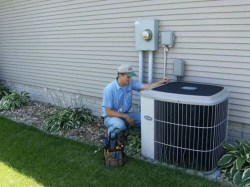Making Our Homes Energy-Fit For The Future – Business News Wales
Energy Disrupter
When Prime Minister Boris Johnson outlined his Ten Point Plan for a Green Industrial Revolution in November 2020, it was no coincidence that Point 1 and Point 2 – the generation of Offshore Wind and production of Hydrogen power – focused on delivering clean and green energy capable of powering every UK home by 2030.
The Committee on Climate Change’s (CCC) authoritative ‘UK Housing: Fit For The Future’ report has shown that the UK’s legally-binding climate change targets will not be met without the near-complete elimination of greenhouse gas emissions from UK buildings – and with the country’s 29 million homes accounting for 14% of total UK emissions, there’s a clear and urgent need to adapt our housing stock for the higher average temperatures, flooding, water scarcity and the other climate challenges that are forecast for the homes we live in by the mid-century.
The target is for clean, green energy to power every UK Home by 2030
Little wonder that the government is looking to quadruple off-shore wind production, creating 40GW by 2030 – and is working with industry to generate 5GW of low carbon hydrogen by the end of this decade, including development of the first town to be heated entirely by hydrogen. This transformation presents particular challenges – and opportunities – for the Cardiff Capital Region (CCR), with a report in July 2019 by the Decarbonisation of Homes in Wales Advisory Group saying that the 750,000 homes in South East Wales are responsible for 27% of all energy consumed across CCR. The report stated that our region has some of “the oldest and least thermally efficient housing stock in Europe” – recommending a 30-year ‘decarbonisation’ of homes across the region by 2050, with every property meeting the ‘climate-resilient’ standards of being low carbon, water and energy efficient; and all housing stock retro-fitted to attain a band A energy rating by the mid-century landmark.
750,000 homes are responsible for 27% of all energy consumed across CCR
With policy experts at the Institute of Welsh Affairs (IWA) predicting that CCR could meet all of its energy needs from renewable energy sources by 2035 (through a blend of electricity and hydrogen produced by solar, offshore wind, tidal power, hydropower, geothermal and fusion energy) as well as creating thousands of new jobs and billions of pounds of extra GVA to the region, the domestic energy transformation can’t come quick enough for the Cardiff Capital Region – or anywhere else in the UK for that matter, with Baroness Brown, Chair of the CCC Adaptation Committee warning: “the climate change will not wait while we consider our options.”
So what will the forthcoming domestic refit ‘look like’ – will there be a solar panel on every roof, a heat pump and smart meter in every home and a private electric vehicle charging point in every property? How will this refit actually be rolled-out to ensure that every home has low-carbon sources of heating and high levels of home energy efficiency? And what is the blend of green energy that will power our homes in the 21st century? Some of the above is already apparent, some still open to refinement, but this much we already know.
CCR could meet all of its energy needs from renewable energy sources by 2035
In spring 2019, then Chancellor of the Exchequer Philip Hammond announced that ‘fossil-fuel heating systems’ (such as gas and oil) would not be installed in any domestic new-build properties from 2025, as part of the Future Homes Standard. From that day onwards it’s become increasingly inevitable that the UK would move towards heating systems powered by renewable energy which reduces the carbon footprint in every home, with two options being viewed as integral to that ‘future’:
Heat Pumps are one of the most obvious replacements, using a refrigerant to absorb the natural heat that can be found in the ground, air or water. This refrigerant is compressed to further increase the temperature, which can then be used to heat the cold water in the system – before being pumped to our radiators or supplied to our hot water taps. Heat pumps work solely by using electricity, which can be generated from renewable sources that don’t directly produce any carbon emissions – and can even generate excess energy that can be sold back to the National Grid.
Hydrogen-ready Boilers. Many argue that solar energy and heat pumps will not be sufficient to power every home in the UK – and hydrogen-ready boilers are seen as the most viable alternative to the present fossil-fuel systems, as they can make use of the existing infrastructure and engineers (with a price point that is likely to remain competitive). The first homes with hydrogen boilers in the UK commenced build in April this year (in Gateshead) and from next year (in Fife, Scotland), hydrogen appliances will be trialled in over 300 homes fed with hydrogen gas directly from the National Grid.
Fully decarbonised eco-systems are being trialled and tested on a wider scale
With heat pumps, hydrogen boilers and the whole spectrum of renewable energies emerging on the horizon, a number of collaborations are trialling and testing fully decarbonised eco-systems on a wider scale.
Active Buildings. The Active Building Centre is a joint project between Swansea University and a number of pioneering organisations, using active building technologies to transform how buildings use energy, turning them from energy consumers into energy providers. The centre has secured a £36 million investment through the Industrial Strategy Challenge Fund’s (ISCF) Transforming Construction Challenge Programme – and has already successfully piloted beautifully designed homes and comfortable workspaces, powered by self-generated clean energy that makes energy bills and carbon emissions a thing of the past, integrating renewable technologies for heat, power and transport (and when connected with other Active Buildings in a network, even possessing the ability to trade energy as part of a circular economy).
Hydrogen-blended Heat for Housing. Hoare Lea, Pobl and Ynni Glan are currently working together to develop an apartment complex for older people in Newport, South Wales – exploring options to blend hydrogen with natural gas to reduce emissions from the onsite heating system. This pilot is part of the UK programme to deliver the Prime Minister’s target of blending up to 20% hydrogen into Britain’s gas network from 2023, so that Britain’s homes can reduce their carbon emissions by the equivalent of 2.5 million cars a year – achieved without anyone having to change their household appliances.
Smart Local Energy Systems. The Milford Haven Energy Kingdom project is exploring what a decarbonised smart local energy system could look like for the Milford Haven Waterway – including the potential of hydrogen as part of a multi-vector approach to decarbonisation. The local energy system is being designed to put local communities and industry at the centre of the project – achieving a net-zero target through local renewable energy (solar, onshore wind, future offshore wind and biomass) and diversified markets for hydrogen across heat, power, transport and industry sectors.
This two year project will run until 2022, creating investable propositions – and including the demonstration of hydrogen-ready features and technologies such as a hybrid heat pump and hydrogen-ready boiler demo for heating (as well as a hydrogen vehicle refuelling station for Riversimple’s fuel cell RASA cars), allowing people to test real-world hydrogen heating equipment and vehicles, using a comprehensive energy systems architecture.
Building the Gas Goes Green Pathway. Wales & West Utilities has commenced its work programme for the Energy Networks Association (ENA) Gas Goes Green Programme in 2021 – a six-step programme making the changes necessary to convert Britain’s £24bn of gas network infrastructure to run on hydrogen and biomethane instead, without the need for people to change their household appliances. Biomethane alone could deliver a 6% reduction in the UK’s greenhouse gas emissions by 2030, providing heating for 6.4 million homes.
The initial Planning & Research step is moving towards the second step – Facilitating the Connection of More Green Gas – which includes putting in place the right licensing arrangements to build the infrastructure through Britain’s industrial heartlands, blending 20% of hydrogen into the domestic gas network by 2023 (as detailed in our earlier Newport pilot) – and boosting biomethane production by creating more space for farmers and other biomethane producers, by converting existing biogas power plants and streamlining the gas grid connection process for biomethane and hydrogen.
As Cardiff Capital Region, Wales and the UK as a whole transforms to a clean and decarbonised energy, many brave interventions will be required by government – and countless behavioural changes will need to be made by all of us. The small businesses that drive our economy are beginning to lead the way in this behavioural change – and we’ll be looking at a number of those individual businesses in our next few features, starting with Riversimple, the Monmouthshire-based SME that’s driving change by manufacturing locally-built hydrogen cell powered vehicles.
Original Source: https://businessnewswales.com/making-our-homes-energy-fit-for-the-future/














